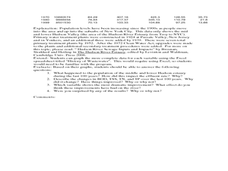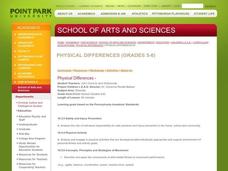King Country
Lesson 4: Relationships - Day 2: Gender Identification
Gender roles and gender identity are the focus of a instructional activity designed for high school special education classes. Read the introduction to the packet carefully, as it contains advice about how to approach the subject with...
King Country
Lesson 9: Communication - Day 2: Assertiveness
Appropriate assertive and non-verbal assertive communication is the focus of this lesson plan designed for the special education classroom. Using mirrors, class members practice assertive responses to a variety of situations.
King Country
Lesson 8: Communication - Day 1: Non-Verbal Communication
As part of their study of communication skills, class members practice using verbal and non-verbal techniques to appropriately express their feelings.
King Country
Lesson 10: Communication - Day 3: Asking for What You Want
High schoolers practice appropriate verbal and non-verbal methods of asking for what they want in a lesson designed for the special education classroom.
King Country
Lesson 28: Resources & Review - Day 2: Summary Session
To conclude the unit on family life and sexual health (FLASH), class members review the unit topics and reflect on what the have learned and accomplished.
King Country
Lesson 24: HIV/AIDS & Other STDs - Day 1: Germs & Risk
This first lesson on sexually transmitted diseases focuses on germs, what they are, how they travel, and methods of protecting oneself from germs.
King Country
Lesson 25: HIV/AIDS & Other STDs - Day 2: Sexually Transmitted Diseases
Sexually transmitted diseases (STDS) are the focus of a lesson that examines different types of STDs, how to avoid catching or transmitting these diseases, identifying the symptoms of STDs, and reporting procedures.
King Country
Lesson 11: Communication - Day 4: Hearing "NO"
"No!" Accepting a "No" response and handling rejection appropriately can be a challenge. After reviewing the previous lesson on asking for what they want, class members role-play appropriate ways of responding when their request has been...
King Country
Lesson 27: Resources & Review - Day 1: Resources
To conclude a unit on family life and sexual health (FLASH), class members use the skills they have practiced in previous lessons to develop strategies for getting information or help when they need it.
Curated OER
Understanding Points of View
Develop an understanding of point of view in your young learners. Read narrative stories to your class and discuss who the storyteller is. Point out different points of view and discuss new vocabulary in order to introduce this concept....
Curated OER
Historical Pollution in the Hudson: Part 2
Ninth graders practice how to format and enter data into an Excel spreadsheet, make a graph, and interpret graphed data. They recognize how the pollution in the Hudson River has changed over time, and explain the consequences of these...
Federal Reserve Bank
The Fed - Helping Keep Banks Safe and Sound
What does an examiner look for when analyzing a bank's financial condition? In addition to learning about the 5-Cs for reviewing loans and CAMELS (capital, assets, management, earnings, liquidity, and sensitivity to risk), your learners...
Rainforest Alliance
Investments in Forest Carbon
One hundred metric tons of CO2 can accumulate in one acre of forest over time—that's a lot of carbon! In the activity, groups of middle school learners determine what makes forests important. They then solidify the concept by using a...
Curated OER
My Side of the Mountain
Learners complete activities with the book My Side of the Mountain by Jean Craighead George. In this literature lesson, students read the book and discuss the concept of human capital. They complete a KWLH chart and two assessments.
Curated OER
What are Hunger and Malnutrition and Who are the Hungry?: Food, Ethics, Global Cultures
Students explain the consequences of hunger and malnutrition, to know the magnitude of hunger in the world today and to know who is hungry and malnourished in the world.
Curated OER
The Quicker the Better? Food Processing
Sixth graders explore food processing. In this food processing lesson, 6th graders investigate the effects of processing foods on the food's nutritional value. Students examine a variety of healthy snack options.
Curated OER
Healthy People 2010
Ninth graders log on to the attached website. They use the "Online Slide Show" and think about the questions in the guide. They complete the slide show and guide, then and share their suggestions with the class.
Curated OER
P.H.A.T Log
Students complete a P.H.A.T Log which records their nutrition and daily activities. They complete a reflections journal based on the entries.
Curated OER
Diversity
Students access prior knowledge of the five senses and relate to students with disabilities. In this people with disabilities instructional activity, students research and use a Venn diagram to compare and contrast famous people and...
Curated OER
Get Your Calcium-Rich Foods
Sixth graders explore foods in the dairy group. In this dairy food lesson, 6th graders examine the nutritional value of dairy foods and determine the proper number of dairy servings per day. Students also evaluate numerous food labels of...
Curated OER
Give Me Five A Day!
Students engage in a lesson lead by the teacher to discover the diet plan of increasing the consumption of fruits and vegetables. They conduct discussions in class with each other, at home with parents, and in the community if possible.
Curated OER
Meet Your Tonsils
Students engage in a lesson that is concerned with tonsils. They identify the parts of the face and mouth as shown on a poster and then conduct class discussion about the function and location of the tonsils. The lesson includes related...
Curated OER
My Journey From Innocence
Young scholars discuss the factors that may or may not influence the outcome of a sexual experience. After reading a brief article about a student losing their virginity, students discuss the ways a sexual experience can have a...
Curated OER
Getting the Most Nutrition From Your Food
Fifth graders research the food pyramid. In this food pyramid lesson, 5th graders track their eating habits during the day. Later, students review their food log and place each item into the food pyramid.

























